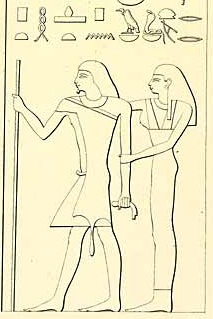Ptahhotep
| Ptahhotep | |
|---|---|
| Vizier | |
 Drawing of Ptahhotep and his wife Khamerernebty from their tomb in Saqqara. | |
| Dynasty | 5th Dynasty |
| Pharaoh | Djedkare Isesi |
| Wife | Khamerernebty |
| Children | Akhethotep |
| Burial | a Mastaba in Saqqara |
Ptahhotep (ptāħ ħwtp), sometimes known as Ptahhotep I, Ptahhotpe or Ptah-Hotep, was an ancient Egyptian Vizier during the late 25th century BC and early 24th century BC.
Life
Ptahhotep was the city administrator and vizier (first minister) during the reign of Djedkare Isesi in the 5th Dynasty. He is credited with authoring The Instruction of Ptahhotep, an early piece of Egyptian "wisdom literature" meant to instruct young men in appropriate behavior.
He had a son named Akhethotep, who was also a vizier. He and his descendants were buried at Saqqara.
Ptahhotep's tomb is located in a mastaba in North Saqqara (D 62) where he was laid to rest by himself. His grandson Ptahhotep Tshefi, who lived during the reign of Unas, was buried in the mastaba of his father.[1] Their tomb is famous for its outstanding depictions.[2] Next to the vizier's titles he hold many other important positions, such as overseer of the treasury, overseer of scribes of the king's document, overseer of the double granary and overseer of all royal works.[3]
The Maxims of Ptahhotep
For a long time it was believed that Ptahhotep wrote what to be thefirst book in history by many scholars. His book was entitled The Maxims of Ptahhotep. As the Vizier, he wrote on a number of topics in his book that were derived from the central concept of Egyptian wisdom and literature which came from the goddess Maat. She was the daughter of the primordial and symbolized both cosmic order and social harmony. Ptahhotep’s instruction was written as advice to his people in the hopes of maintaining this said "social order". He wrote perspicacious advice covering topics from table manners and proper conduct for success in court circles to handy hints to the husband for preserving his wife’s beauty. Ptahhotep also wrote more social instructions such as ways to avoid argumentative persons and cultivate self-control.[4]
There are authors who date the Maxims of Ptahhotep came much earlier than the 25th century. For instance, Pulitzer Prize winning historian Will Durant dates these writings as early as 2880 BCE within The Story of Civilization: Our Oriental History. Durant claims that Ptahhotep could be considered the very first philosopher in virtue of having the earliest and surviving fragments of moral philosophy (i.e., "The Maxims of Ptah-Hotep").
Ptahhotep's grandson, Ptahhotep Tshefi, is traditionally credited with being the author of the collection of wise sayings known as The Maxims of Ptahhotep,[5] whose opening lines attribute authorship to the vizier Ptahhotep: Instruction of the Mayor of the city, the Vizier Ptahhotep, under the Majesty of King Isesi.[6] They take the form of advice and instructions from a father to his son and are said to have been assembled during the late Old Kingdom. However, their oldest surviving copies are written in Middle Egyptian dating to the late First Intermediate Period of the Middle Kingdom.[7] That means that the book was more likely composed in the Middle Kingdom and the authorship is fictional.[8]
The 1906 translation by Battiscombe Gunn, published as part of the "Wisdom of the East" series, was made directly from the papyrus in Paris, rather than from copies, and is still in print.[9]
A manuscript copy, the Prisse Papyrus, is on display at the Louvre.
Modern influence
In the popular 1960 book Initiation, author Elizabeth Haich makes the claim that in a past life she was the disciple and niece of Ptahhotep. Also, in an episode of Quantum Leap called "The Curse of Ptah-Hotep", Sam Beckett leaps into an archeologist named Dale Conway as he and a colleague uncover the tomb of Ptah-Hotep.
References
- ^ Grimal, p.79
- ^ Dieter Arnold, The Encyclopaedia of Ancient Egyptian Architecture, I.B.Tauris 2003, ISBN 1-86064-465-1, p.182
- ^ Strudwick 1985, pp. 87.
- ^ Fontaine, Carole (1981). "A Modern Look at Ancient Wisdom: The Instruction of Ptahhotep Revisited". Biblical Archaeologist. 44 (3): 155–160.
{{cite journal}}: Italic or bold markup not allowed in:|journal=(help) - ^ Grimal, p.79
- ^ M. Lichtheim, Ancient Egyptian Literature, p.61
- ^ James P. Allen, Middle Egyptian: An Introduction to the Language and Culture of Hieroglyphs, Cambridge University Press 2000, ISBN 0-521-77483-7, p.259
- ^ Quirke 2004, pp. 90.
- ^ Battiscombe G. Gunn, "THE WISDOM OF THE EAST, THE INSTRUCTION OF PTAH-HOTEP AND THE INSTRUCTION OF KE'GEMNI: THE OLDEST BOOKS IN THE WORLD", LONDON, JOHN MURRAY, ALBEMARLE STREET, 1906, https://www.gutenberg.org/files/30508/30508-h/30508-h.htm
Bibliography
- Nicolas Grimal, A History of Ancient Egypt, Blackwell Publishing, 1992
- Quirke, Stephen (2004). Egyptian Literature, 1800BC, questions and readings. G. London,: GHP. ISBN 0954721861.
{{cite book}}: Invalid|ref=harv(help)CS1 maint: extra punctuation (link) - Strudwick, Nigel (1985). The administration of Egypt in the Old Kingdom: the highest titles and their holders (PDF). Studies in Egyptology. London, Boston: KPI. ISBN 978-0-71-030107-9.
{{cite book}}: Invalid|ref=harv(help)
External links
- Works by Ptahhotep at Project Gutenberg
- Works by or about Ptahhotep at the Internet Archive
- "Ptah-Hotep", AfricaWithin.com
- Brian Brown (ed.) (1923) The Wisdom of the Egyptians. New York: Brentano's
- Texts from the Pyramid Age by Nigel C. Strudwick, Ronald J. Leprohon, 2005, Brill Academic Publishers
- Ancient Egyptian Science: A Source Book by Marshall Clagett, 1989
- The Instruction of Ptah-Hotep - AAA Encyclopedia
- "The Maxims on Good Discourse of Ptahhotep".
{{cite web}}: Cite has empty unknown parameter:|1=(help)
